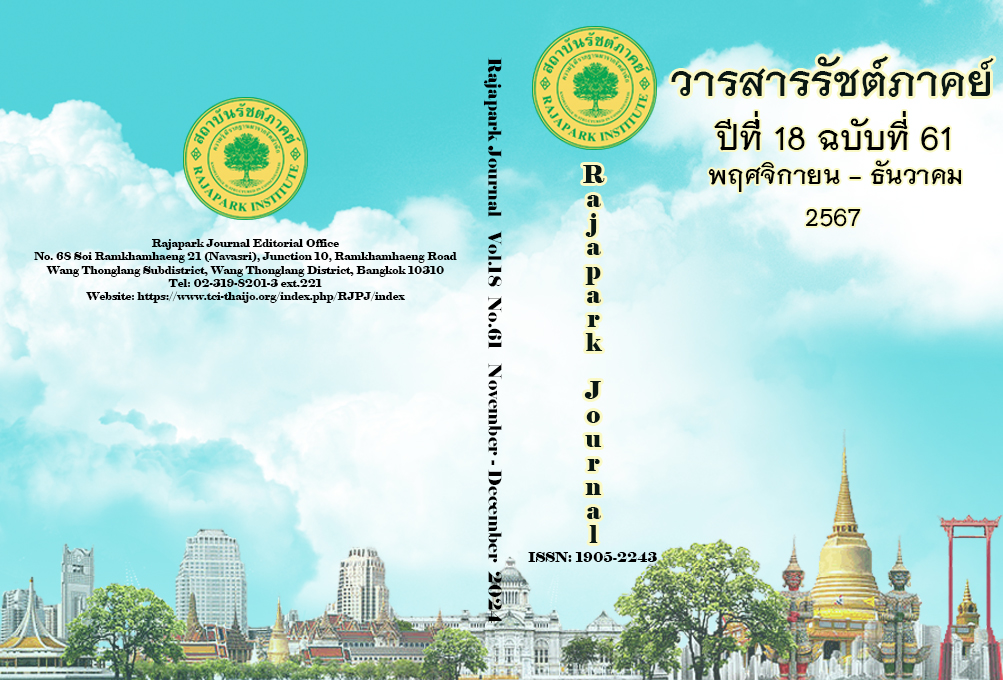Value Addition to Grasshopper Products through Processing and Marketing Development Strategies
Main Article Content
Abstract
This research aimed to study the value addition of grasshopper products through processing, analyze the marketing factors that influence value creation, and develop appropriate strategies for processed grasshopper products. The sample included 432 consumers who had previously consumed insects in Sa Kaeo Province and 30 key informants, totaling 462 participants. Data were collected using a questionnaire with a reliability coefficient of 0.84. Statistical analysis included descriptive statistics such as mean and standard deviation, as well as inferential statistics including t-test, One-way ANOVA, and Pearson Chi-Square. The research findings revealed that the value addition to grasshopper products through processing and the marketing factors influencing consumption and purchasing decisions were significantly correlated, with a Pearson Chi-Square value of 33.989 and a significance level of 0.000*. Additionally, the perception of grasshoppers as highly nutritious was significantly related to the purchasing decision, with a Pearson Chi-Square value of 19.18 and a significance level of 0.000*. The marketing mix factors influencing value addition were ranked as follows: marketing promotion and product were at a high level, distribution channels were at a high level, and price was at a moderate level. The comparison of satisfaction with distribution channels between male and female respondents showed a significant difference at the 0.05 level. The strategy for developing processed grasshopper products included creating a dried grasshopper seasoning with a green cap sauce flavor that is familiar to consumers, as well as designing packaging that clearly represents the product and its flavor.
Article Details

This work is licensed under a Creative Commons Attribution-NonCommercial-NoDerivatives 4.0 International License.
Views and opinions appearing in the Journal it is the responsibility of the author of the article, and does not constitute the view and responsibility of the editorial team.
References
Boone, L.E., & Kurtz, D.L. (1998). Contemporary marketing (9th ed.). Dryden Press.
Bureau of Animal Nutrition Development, Ministry of Agriculture and Cooperatives, Thailand. (2016, May 12). Water Crisis and Livestock. https://nutrition.dld.go.th/nutrition/index.php /2017-09-26-01-39-06/380-2016-05-12-04-36-25
Chaisuwan, B., Daoh, A., Chanesirirattanakorn, T., & Wizartpong, M. (2022). Participatory action research for developing community’s product and digital marketing communication guideline to raise the community economy in sustainable way. Sukhothai Thammathirat
Open University Journal, 35(2), 63-85. https://so05.tci-thaijo.org/index.php/stouj /article/view/260701
Department of Provincial Administration. (2024). Official statistics registration systems. https://stat.bora.dopa.go.th/stat/statnew/statMenu/newStat/home.php
Espitia Buitrago, P. A., Hernández, L. M., Burkart, S., & Palmer, N. (2021). Forage-fed insects as food and feed source: opportunities and constraints of edible insects in the tropics. Frontiers in Sustainable Food Systems, 5, 724628. https://doi.org/10.3389/fsufs.2021.724628
Jaruswatthanaphun, P., & Pantong, S. (2023). The influences that affect sleep supplement purchasing decisions of consumer online. Suthiparithat Journal, 37(2), 116-131. https://so05.tci-thaijo.org/index.php/DPUSuthiparithatJournal/article/view/263068
Kotler, P., & Keller, K. L. (2016). Marketing management (15th ed). Pearson Education.
Krejcie, R. V., & Morgan, D. W. (1970). Determining sample size for research activities. Educational and Psychological Measurement, 30(3), 607-610.
Mayura, P. (2022). Consumer behavior towards cricket burger decision making and effective digital marketing communication guidelines for generation Y in Thailand: A case study of bounce burger[Independent studies, Bangkok University]. http://dspace.bu.ac.th/jspui/handle/123456789/5307
Nakakes, K. (2018). Processed food. http://lib3.dss.go.th/fulltext/dss_knowledge/BLPD_1_2561_food.pdf
Office for Agriculture and Cooperatives Sa Kaeo, Thailand. (2024, April 30). Information of Sa Kaeo Province, April 2024. https://www.opsmoac.go.th/sakaeo-dwl-files-461191791124
Office of Commercial Affairs in Miami, USA. (2020). Insect food product report in the United States. https://www.ditp.go.th/contents_attach/644352/644352.pdf
Ratanacoon, P. (2021). The differences in gender and type of personality that affect the marketing strategy of “brand’s” products in the students at Rajamangala University of Technology Tawanok, Bangphra Campus. Journal of Social Sciences and Buddhist Anthropology, 7(4), 231-242. https://so04.tci-thaijo.org/index.php/JSBA/article/view/254874
Saepae, P. (2020). Faculty of Science, Mahidol University. Production of protein powder from insects, in collaboration with various institutions, developed into local products with international quality standards. https://science.mahidol.ac.th/th/activity/apr63-13.php
Schiffman, L. G., & Kanuk, L. L. (1991). Consumer behavior (4 ed.). Englewood Cliffs.
Serirat, S. (2017). Modern marketing management. Dhammasarn.
Serirat, S. (2007). Consumer behavior. Teera Film & Scitex.
Sjøgren, K. (2017, May 17). How much more environmentally friendly is it to eat insects?. ScienceNordic. https://www.sciencenordic.com/agriculture--fisheries-climate-climate-solutions/how-much-more-environmentally-friendly-is-it-to-eat-insects/1445691
Sukhothai Thammathirat Open University, School of Human Ecology. (2014). Course materials for food preservation and processing technology (2nd ed.). Sukhothai Thammathirat Open University Press.


